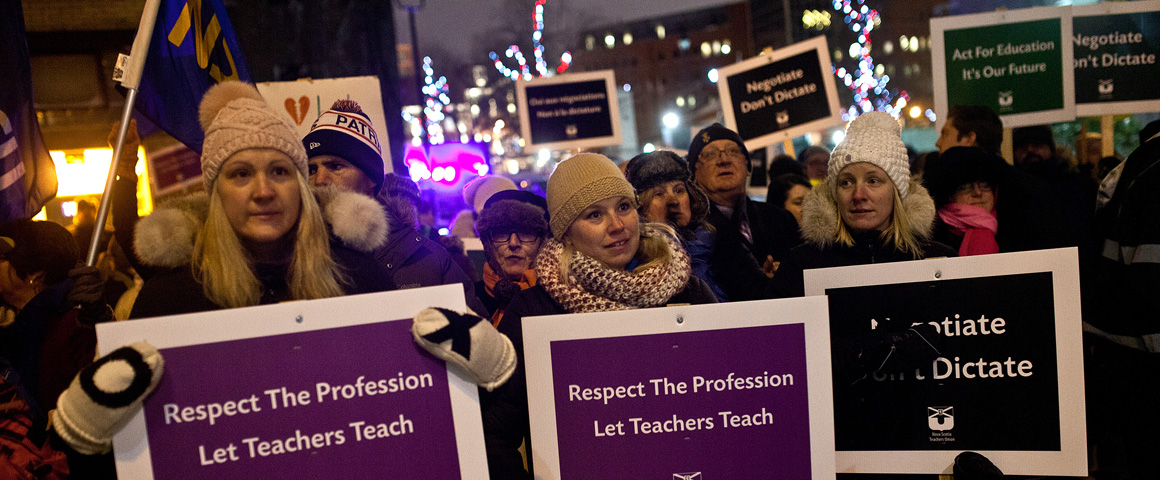In Canada, the politics of the left are sometimes fought out in court. The recent decision of the Nova Scotia Teachers Union (NSTU) to launch a legal challenge against draconian legislation over-riding the right of its members to collective bargaining, is a case in point.
The militant strikes of the dirty thirties got particularly rough in Nova Scotia, which in that era led the country in both the frequency of strikes, and in strike related violence. When her coal mining sons and daughters marched for a living wage, the company police opened fire, and the government threw communist leaders, men like J.B. McLachlan, in jail on trumped up charges of “seditious libel”. All the while, the newspapers blamed it on the Russians (sound familiar?).
Sometimes, however, you have no choice but to fight back.
The scene of the battle in Nova Scotia has changed from the coal mines to the classroom, but the dirty tricks played by the business class have not. In a desperate attempt to move an intransigent government, Liette Doucet, President of the Nova Scotia Teacher’s Union (NSTU) led her members through a work-to-rule job action and an unprecedented province–wide strike, but to no avail. On February 21, the Liberal Government passed Bill 75, legislating teachers back to work under terrible working conditions and with a loss in pay.
Despite the representations of Doucet and many teachers to the Law Amendment Committee, neither the government nor the media recognized the real issues of class size that face Nova Scotia schools. In fact, according to Doucet, the Nova Scotia government denied the right of hundreds of teachers to speak to the Committee for the first time in its history. Those Teachers who did make it to the mike could not have stated the problem more clearly. English teacher Tara Arseneau said: “40 students per class is the norm; 35 students is considered a small class”. One parent who spoke to the Committee had asked his son what he would wish for at his school? His son replied, “to have a class with less than 40 students”!
All other provinces have either hard caps or targets for class sizes at all levels of public school. At the York Region District School Board where I work as a high school teacher, the maximum class size in grade 12 is 30. But there are no such caps on class size under Bill 75 for Nova Scotia High Schools!
Moreover, according to Doucet, what caps there are for elementary and junior high schools are often pierced so that teachers may face grade five or six classes with 32 or more students. This is an impossible workload, and a very bad learning environment. Bill 75 has set up a teacher-led Council to Improve Classroom Conditions to address these issues but, Doucet complains, there was no consultation with union leaders in the selection of teachers, or in the design of the application process. As a result, regions and subject areas are under-represented. Was it the government’s intention to stack the Council with corporate-climbers, eager to please their superiors?
Of course, increasing workloads is one way to keep down teacher wages, but the Nova Scotia government also had other tricks up its sleeve. Bill 75 rescinds hard-earned “long-term service awards” which amounted to the accumulation of 1% per year of a teacher’s salary to be paid out upon retirement, and which many teachers count on to compensate for the recent de-indexation of their pensions. The Bill also limits wage increases to only 3% over four years, far below the current rate of inflation which sits at 2%.
But why is the Liberal government so committed to austerity measures, even at the expense of the education of its children, when Nova Scotia ranks in the top half of Canadian provinces in terms of account balance, and debts service charges are at a quarter century low, according to the Canadian Centre for Policy Alternatives?
No doubt the explanation lurks in the Broten Report commissioned by the Liberal Government in 2014, which calls for the current freeze on government spending to be followed by a lowering of personal and corporate tax rates. Broten, a former Ontario Liberal Cabinet Minister, argues that the existing rates say, “We don’t want entrepreneurs here. That we don’t want people who will take risks, who will build businesses.” In 2015, Broten was appointed head of the Nova Scotia Business Development Agency. Her salary is $210,000 per year.
All of this has left her members feeling demoralized, says Doucet. However, they are determined to pursue the case in court despite the government’s claim that it has bargained in “good faith”, in accordance with recent Supreme Court Decisions on collective bargaining. This is because over a two-year period of negotiations, NSTU members rejected three contract offers recommended by their union leadership. Doucet argues that no genuine negotiations were ever really possible. The Liberal Government held the threat of back-to work legislation over their heads throughout the process, and had already proclaimed its commitment to a wage freeze before negotiations began.
Doucet has been around unions for a long time. In fact, her father was once President of the NSTU. Given the success of the Ontario and British Columbia teachers in similar cases, legal action would seem to have a good chance of progress. However, her father never led a province-wide strike.
Perhaps in these more turbulent times, teachers might benefit from looking further back into the past, to the days when McLachlan sought to strengthen worker militancy. Of course, there was the day McLachlan narrowly escaped with his life by diving behind a desk just in time to avoid a bullet shot by an undercover company saboteur.




